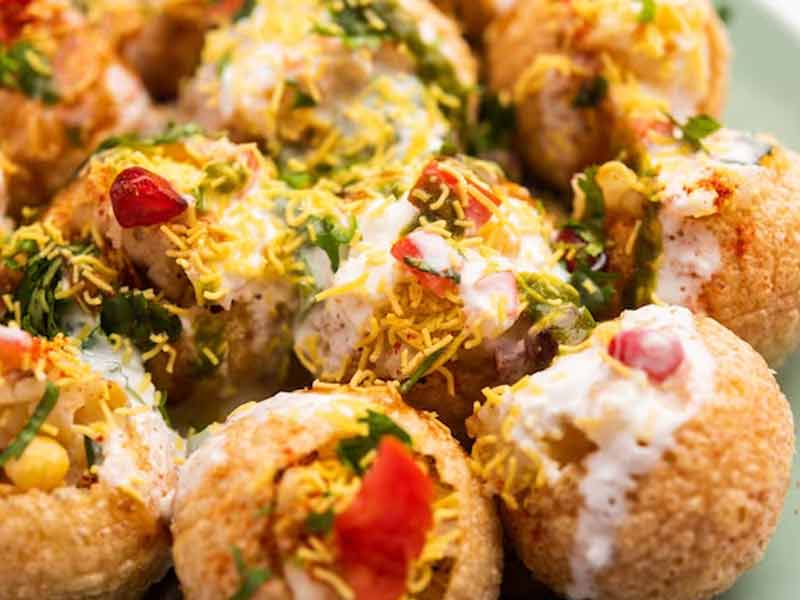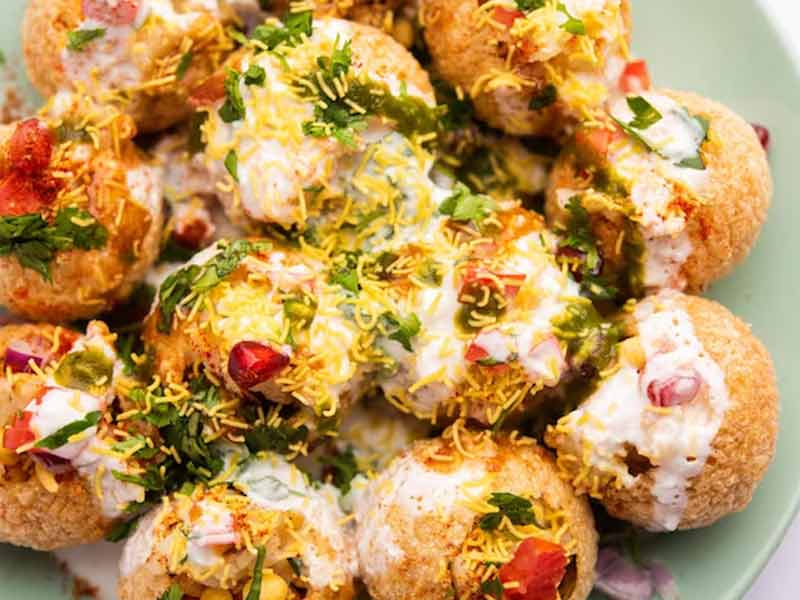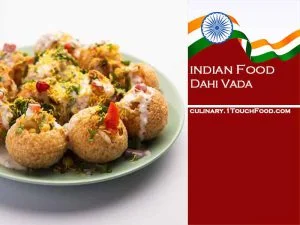Cooking time
- Preparation time
- 5 mins
- Cooking time
- 30 mins
- Difficulty
- moderate
- Serves
- 4 people
- Meal course
- Dinner
- Posted by
- Posted on
- February 27, 2023
Ingredients
- 1 cup
- White lentils(urad dal)
- 1/2
- Chilli
- 1/2 Ts
- ginger root
- 1 As Needed
- oil
- 1 As Needed
- Salt
- 4 Glass
- warm water
- 1/3 cup
- Yogurt
- 1
- paprika
- 2 Ts
- cumin
- 1 Ts
- Black Pepper
- 1/3 cup
- Fresh Coriander
- 1/4 cup
- Tamarind
- 3 Ts
- sugar powder

Do you like snacks? Are you okay with trying new and different flavours? Dahi Vada is our suggestion for you. These delicious fried balls are prepared with lentils, pepper, ginger, etc. and fried in oil. After frying, it is covered with a layer of sweet yogurt and, depending on the season and which part of India it is cooked in, it is decorated with pineapple pieces, pomegranate seeds, etc. If you are going to try this dish.

Dahi Vada, also known as Dahi Bhalla, is a popular North Indian street food snack that has a long and rich history in India. This savory dish is made of lentil fritters soaked in creamy yogurt and topped with a variety of spices and chutneys. The origins of Dahi Vada can be traced back to ancient India, where it was a staple food in many households.
History of Dahi Vada
The history of Dahi Vada dates back to the Vedic period in India, when Ayurvedic texts first mentioned the use of lentils in cooking. According to these texts, lentils were considered to be an excellent source of protein and were used extensively in Ayurvedic medicine. It is believed that the practice of soaking lentils in water before cooking them was first introduced in ancient India to make them easier to digest.

As time went by, the lentil fritters became a popular street food snack in North India, especially in Delhi and Punjab. The dish was originally known as ‘Dahi Bhalla’ and was made by soaking lentil fritters in a mix of tamarind and mint chutney, and then topped with a generous serving of sweet yogurt. This sweet and tangy combination of flavors quickly became a favorite among locals, and soon the dish began to spread across the country.
In the 18th century, the Mughal emperors brought their own culinary traditions to India, and Dahi Vada evolved even further. The Mughals introduced new spices and cooking techniques to the dish, which gave it a richer and more complex flavor. The dish became so popular among the Mughal elites that it was often served as a starter or side dish during lavish feasts.
During the British Raj, Dahi Vada continued to be a popular street food snack, but it also gained popularity among the British expatriates. The dish was often served in high-end restaurants and hotels, where it was presented as a sophisticated and exotic Indian delicacy. Health coach and its 10 Golden Free benefits

In the post-independence era, Dahi Vada underwent yet another transformation. As India became more modern and urbanized, the dish began to be served in fast food chains and food courts across the country. It was often served as a quick and convenient snack for busy people who didn’t have time to cook at home.
Today, Dahi Vada is one of the most popular street food snacks in India, and it is enjoyed by people of all ages and backgrounds. The dish is now available in a variety of different styles and flavors, and it has become a staple food in many households. Some people even make it at home as a special treat for festivals and other special occasions.

The recipe for Dahi Vada has also undergone many changes over the years. Traditionally, the dish was made by soaking lentil fritters in a mixture of tamarind and mint chutney, and then topping them with sweet yogurt and a sprinkle of spices. However, modern variations of the dish may include different types of chutneys, sauces, and spices, depending on the region and the cook’s personal preferences.
One of the most important points in cooking is the use of fresh and organic ingredients. The first point is to use fresh ingredients.
The more you follow these tips, the better and tastier you will have. Rest assured, you definitely can and you will need some experience. 1TouchFood online cooking training center has put many of training for you.
Please follow us on linkedin. You can learn all best french food recipe and best Italian food recipe and best arabic food recipes and best Iranian food recipes you can check our Reddit page.
How to prepare Best Indian Dahi Vada for 4 people - 1Touch Food Culinary Center

Dahi Vada, also known as Dahi Bhalla, is a popular North Indian street food snack that has a long and rich history in India. Dahi Vada is delicious
Type: Main Dish
Cuisine: Indian
Keywords: Dahi Vada
Recipe Yield: 4
Preparation Time: PT0H05M
Cooking Time: PT0H30M
Total Time: PT0H35M
Recipe Ingredients:
- 1 cup White lentils(urad dal)
- 1/2 table spoon Chilli
- 1/2 Tea Spoon ginger root
- 1 As Needed oil
- 1 As Needed Salt
- 4 Glass warm water
- 1/3 cup Yogurt
- 1 table spoon paprika
- 2 Tea Spoon cumin
- 1 Tea Spoon Black Pepper
- 1/3 cup Fresh Coriander
- 1/4 cup Tamarind
- 3 Tea Spoon sugar powder
Recipe Instructions: The history of Dahi Vada dates back to the Vedic period in India, when Ayurvedic texts first mentioned the use of lentils in cooking. According to these texts, lentils were considered to be an excellent source of protein and were used extensively in Ayurvedic medicine. It is believed that the practice of soaking lentils in water before cooking them was first introduced in ancient India to make them easier to digest. Enjoy your meals!
5
Instructions
- Soak urad dal in water for 6 hours or overnight. Its size increases almost twice during immersion. After soaking it in water, drain it completely and grind the urad dal until a smooth paste is obtained. Gradually add ½ tablespoon of water or about ½ cup of water to make a smooth paste of urad dal. (Note: the amount of water needed to add to the dough may vary depending on the quality of the urad dal. Be careful not to add too much water because the dough will loosen; it should have the same consistency and no dry and brittle parts)
- Transfer dough to a large bowl and add salt, ginger and chopped pepper. Now mix them well and knead until it becomes a little lighter and brighter, about at least 4-5 minutes.This step is very critical because the vada batter will reach the required softness and softness at this stage which will be perfect and soft after frying. (Excessive kneading damages the softness of the dough.)
- Pour the oil into a deep-frying pan and put it on a medium flame. When the oil is hot, make balls of dough in your palm and drop them in the oil. Fry about 4 to 5 dough balls at a time on one side. Put them on medium heat until they become reddish-golden and crispy. After frying, take it out of the oil and transfer it to a bowl with lukewarm water. Fry the rest of the dough in the same way. Soak them in water for about 7–8 minutes. The oil droplets start floating on the surface and the vada becomes soft.
- Take them out of the water and gently squeeze them between your palms to remove excess water. (This method also drains excess oil) Transfer some of them to another container. (serving dish)
- On the other hand, mix the yogurt with sugar or salt until it becomes smooth. (Do not use an electric mixer to mix it so as not to lose its texture)
- Pour a large amount of yogurt evenly on all parts of the lentil balls to cover them completely. Put 2 teaspoons of tamarind, coriander leaves, some red pepper powder, cumin powder and black pepper powder on it. In different seasons of the year, it can be decorated with pears, pineapples, pomegranate seeds, etc.
No comments yet, be the first to leave one!